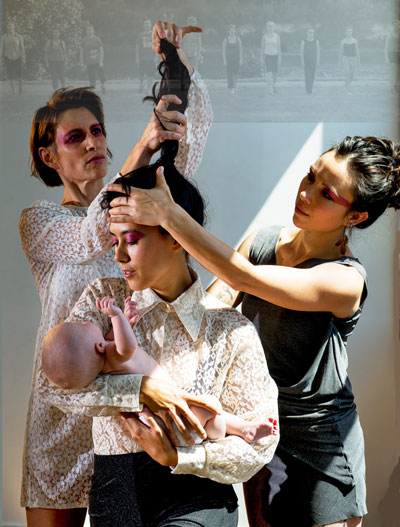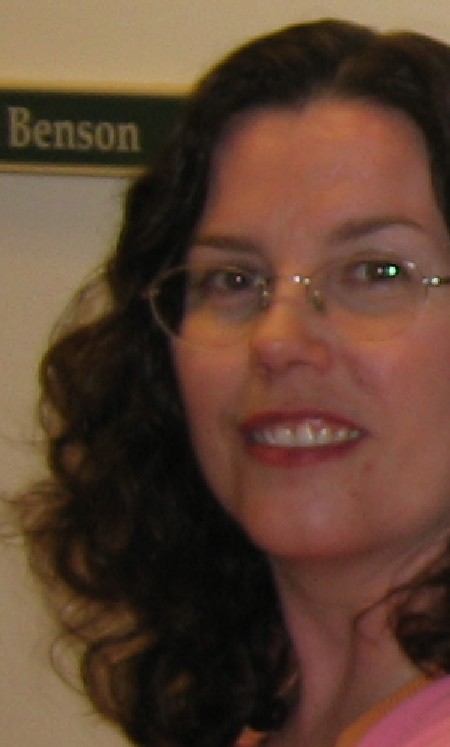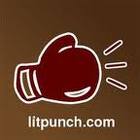The Writing Life: An Interview with Emily Johnson

 Emily Johnson (on the right in the photo) is a dancer and choreographer based in the Twin Cities. Originally from Alaska, her work with her company Catalyst explores the fringes between art forms and performance. I sat down with Johnson to interview her about SHORE, a “multi-day performance installation of dance, story, volunteerism, and feasting,” which includes those four different art forms as separate events.
Emily Johnson (on the right in the photo) is a dancer and choreographer based in the Twin Cities. Originally from Alaska, her work with her company Catalyst explores the fringes between art forms and performance. I sat down with Johnson to interview her about SHORE, a “multi-day performance installation of dance, story, volunteerism, and feasting,” which includes those four different art forms as separate events.
The reading, SHORE: STORY, kicks off a week of SHORE events tonight, at the Loft Literary Center. Curated by Johnson, the reading will feature work by Jayal Chung, Paula Cisewski, Heid Erdrich, Brett Elizabeth Jenkins, R. Vincent Moniz, Jr, , Marcie Rendon, and Ben Weaver.
I started out thinking I would just interview her mostly about STORY, but I soon learned that all parts of SHORE are equally connected, and all involve storytelling in some way. So let’s back up, and give you a bit more context.
SHORE is third in a trilogy of works that Emily Johnson has presented locally at Northrop (aka, my day job). The Thank-you Bar, the first in the trilogy, remains one of my all-time favorite performances I’ve ever seen at Northrop. I loved it because it, too, used storytelling to carry the audience through the performance.
Johnson describes the trilogy taking visual form in three concentric circles: The Thank-you Bar is at the center, with Johnson’s own very personal story of missing her home in Alaska. The performance itself took place on the old Northrop stage, with the audience on stage alongside the performers. Niicugni, copresented by Northrop and The O’Shaughnessy, was about the story of a place, and happened on The O’Shaughnessy stage but with performers coming from the audience to the stage and back. Finally, SHORE is a broader scope, including multiple perspectives and stories, as well as multiple stages, if you will.
SHORE: STORY specifically helps to ground SHORE in the community it’s in. Johnson said she thought a lot about what SHORE will look like when it goes on tour. “How can I help SHORE land in a place? Part of that is stories about that place being an active, vital part of SHORE. Start with stories about here. Know where you are from lots of different perspectives and lots of people’s interpretations and lived experiences. And really, listening. I love that SHORE starts with listening. That’s a direct connection to Niicugni, which means listen.”
Johnson will put out a call for readers in each community SHORE tours to, just like she did here. For the local call, which the Loft Literary Center helped her put out, she asked for work about “place, home, land, your connection or disconnection to those thoughts, ideas, places, words. And all of those words can be interpreted widely,” said Johnson. She had initially wanted five readers, but ended up curating eight in the final line-up. “It was an honor to receive these works,” she said.
“Story is an important part of my work, but I want to tell more than my story. So the curated reading is really about local authors telling their stories,” said Johnson. She followed up with “Knowing they were the first part [of SHORE], it took a lot of care and attention. It’s just so thrilling to invite other people into the process. Those stories are part of SHORE, that’s awesome.”
When reading through the works, Johnson felt for those that had some elemental similarities to her vision and intention for SHORE as a performance installation. She felt she is the “mother” for SHORE, guiding along these different events to feed into the larger, cohesive idea of SHORE. As for a continuing thread throughout the work that she ended up selecting, she told me “what was so palpable to me was how writings about place, land, home, really are so personal. That was a surprise. Some through-line is all the works are very personal.”
At SHORE: PERFORMANCE (which takes place at Northrop), Emily starts outside on the Northrop Mall, telling a story. In SHORE: COMMUNITY ACTION, she will have experts (Sharon Day and David Wiggins, for example) there telling the real history of the river, of the community that is being picked up. And at SHORE: FEAST at Foxtail Farms, participants are encouraged to bring a recipe that means something to them, and to share that recipe and story with the rest of the feasters. Johnson’s hope is that these stories trigger other stories, both in the audience and for her.
Johnson said, “As I was reading the work [for STORY], the same thing happens: you start to have your own relationship to it, it starts to spark your own ideas, thoughts.” Join me tonight at SHORE: STORY to start this process of triggering stories while sharing community at the Loft Literary Center, 7:00 pm.
 Editor’s Note: Linda White is a dear literary friend of ours. As the mind behind BookMania, we asked her for her tips on publicizing books. Today we present The Publicity Hit Parade, Part One. Stay tuned for Part Two next Tuesday!
Editor’s Note: Linda White is a dear literary friend of ours. As the mind behind BookMania, we asked her for her tips on publicizing books. Today we present The Publicity Hit Parade, Part One. Stay tuned for Part Two next Tuesday!
by Linda White (BookMania)
When Hazel and Wren asked me to write up something about publicity, they suggested a tips list. It is difficult to boil things down to what might be valuable for the whole of Hazel & Wren’s crowd out there, but the following tips are my hit parade — the things that I find myself repeating over and over. So often, in fact, that I started teaching a class at the Loft Literary Center, which of course expands on all of this.
The Mantra
My main mantra is: Early, early, early. You cannot start promoting your book early enough. By promotion, I mean all types of things: coming up with your elevator pitch, having give-away items made, telling people about your book. Publicity, to be clear, is part of promotion. It has to do with getting your message out through any medium, usually for free. (On the other hand, advertising, where you are guaranteed placement and message, costs — lots.)
A year before your book comes out is not too early to start. The basic timeline for promoting a book in the old-school world was pretty much controlled by the NYC publishers. They have loooong lead times, so they have somehow hoodwinked media into thinking that the media needs to have the book 3 to 6 months before the book comes out. And guess what? It has worked. It is very difficult to get coverage for a book after it is already out. Not impossible, but difficult.
If you have a book already published that you want to promote, find a news angle, a holiday or other observance, or some other way to link it to current events — to make it “news-worthy.” The main reason that many publishers want to get their books out early is so that all of those reviews and interviews hit during the launch month. The consumer is bombarded with this book over and over in a short period of time. That’s one of the basic tenets of marketing – repeating the message. So give yourself a new “launch” date and operate accordingly.
Pitching It
Here is the bottom line: Your book has to be something that can be talked about in order to get media coverage. What’s your angle? What’s your platform? Even for a fiction piece, there has got to be something. Maybe it’s the extreme research you did. Maybe it’s the character based on your estranged father and the story of that estrangement, the writing of which resulted in a reconciliation after thirty years (don’t roll your eyes, this happened). Whatever it is, you need to figure it out. The media will not figure it out. Do not — I repeat — do not expect them to read your book and simply want to talk to you because it’s the Best Story Ever. Not gonna happen.
Remember, your relationship with the media is a partnership. You are providing them content for the service they provide. They are not doing you a ‘favor.’ And you are not pitching a book to them — you are pitching a story. Know who you are pitching to — check out their website, and whenever possible, watch or listen to the program, or read the publication. Make sure you know why their audience would care. Give them ideas, and try to be creative. It also helps to be as specific as possible: if you want a review, say so. If you want a profile, say so. If you want an on-air review, ask for that, or if you want an on-air interview, ask for that. Don’t make them guess how they can use you or your book.
… to be continued next Tuesday on The Writing Life!
Linda White is a professional reader. She runs BookMania, which offers editorial and publicity services. She is currently wearing many hats, which makes her very happy. Linda is the Minneapolis Books Examiner, is working on a Book Arts Certificate at the MCBA and recently started reviewing books for Library Journal.

 All I hear about lately in the Twin Cities literary scene is punch this, punch that, wanna get punched? No, Minneapolis is not getting over its Minnesota nice and finally going to B-E AGGRESSIVE. So what are they all so nutso about? It’s the new Twin Cities Literary Punch Card, which had its kick-off event last night at Club Jäger. Beers were had, tweeps met face-to-face, and elbows were rubbed with, well, everyone. It was a full house, eager to be punched.
All I hear about lately in the Twin Cities literary scene is punch this, punch that, wanna get punched? No, Minneapolis is not getting over its Minnesota nice and finally going to B-E AGGRESSIVE. So what are they all so nutso about? It’s the new Twin Cities Literary Punch Card, which had its kick-off event last night at Club Jäger. Beers were had, tweeps met face-to-face, and elbows were rubbed with, well, everyone. It was a full house, eager to be punched.
The Punch Card is sponsored by a bunch of literary organizations in town (Coffee House Press, Milkweed Editions, Graywolf Press, Rain Taxi, and the Loft Literary Center), in partnership with a bunch of local, independent booksellers (Magers & Quinn, Micawbers, Common Good Books, and more). If you go to eligible literary events around town (most of them), you get your card punched. Once you fill it up (12 is the magic number), the punch card magically transforms into a $15 gift card to participating bookstores. It’s a great way to get the community excited and involved. Also a wonderful way to find out about some exciting events happening in the Twin Cities area with stellar writers.
For this week’s What We’re Reading, I’ve flagged a handful of upcoming Punch-eligible events that feature authors I’ve read recently. Click on them to find out more on our Mpls/St. Paul Literary Calendar, or visit Rain Taxi’s calendar.
1. Kathryn Kysar and Jim Moore (Sept 18)
If you haven’t read my What We’re Reading post on Kathryn Kysar‘s poetry collection Pretend The World, you should. It’s a beautiful collection on the reality of motherhood, of being a woman, and of nature.
I haven’t yet read much Jim Moore (do I see a Jim Moore WWR post in my future?), but he’s got loads of awards and published work. Have any of you read him? What is your take on his work?
2. Nancy Paddock (Sept 20)
I stumbled upon Paddock through my apprenticeship at Red Dragonfly Press, where I discovered many great poets. Paddock has a strong, calm voice, and writes about nature, the process of aging, and much more, always with a playful sense of wonder. This event focuses on her newest work, a memoir called A Song at Twilight: of Alzheimers and Love.
3. Danielle Sosin (Sept 22)
Sosin’s novel The Long-Shining Waters is on my list of favorite books from 2011. The story centers around Lake Superior, and the intense draw, frightening power, and dark mysticism it holds for three women, each living in different time periods near the lake. Sosin doesn’t just write the story—she crafts it. Each of the characters are significantly different, but are connected through this one natural landmark in such a unique and heart-wrenching way.
4. Ed Bok Lee and Bao Phi (Sept 24)
Lee and Phi are two spoken word poets who perform both on the local and national stage of slam poetry, with a big stir. They both explore racism, culture, and history with a fresh, current voice. While launching Lee’s and Phi’s newly released poetry collections (Whorled and Sông I Sing, respectively), this event also spotlights their publisher, Coffee House Press. It’s a slam-dunk evening with a reading, Q&A, conversation with the poets, spoken word artist Shá Cage emceeing, music from DJ Nak, and, of course, free refreshments. Check out the other spotlight events happening this fall, if you’re in town.
Are any other cities doing promotions like this to get literary people out and about? Have you read any of these writers? If so, what are your thoughts on their work?






